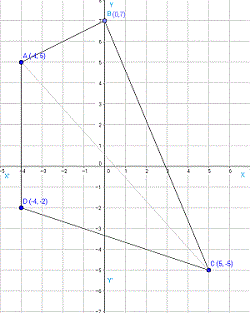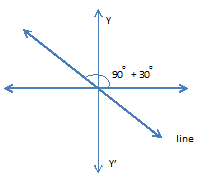Straight Lines - Solutions
CBSE Class–11 Mathematics
NCERT Solutions
Chapter - 10 Straight Lines
Exercise 10.1
1. Draw a quadrilateral in the Cartesian plane, whose vertices are  and
and  Also, find its area.
Also, find its area.
Ans. Let and be the vertices of the quadrilateral
Join the vertices A and C to obtain the diagonal AC
Area of quadrilateral ABCD = Area of triangle ABC + Area of triangle ACD....................(i)
But we have area of a triangle with vertices and is
 Area of triangle ABC =
Area of triangle ABC =
= square units
Also Area of triangle ACD =
= square units
 From equation (i) we haveArea of quadrilateral ABCD = square units
From equation (i) we haveArea of quadrilateral ABCD = square units

2. The base of an equilateral triangle with side  lies along the
lies along the  axis such that the mid-point of the base is at origin. Find the vertices of the triangle.
axis such that the mid-point of the base is at origin. Find the vertices of the triangle.
Ans. Given: Length of side of equilateral triangle =  . The base of triangle lies along
. The base of triangle lies along  axis and the mid-point of base is at origin so that the coordinates of vertices are
axis and the mid-point of base is at origin so that the coordinates of vertices are  and
and 
We have for an equilateral triangle line from the vertex to the mid point of the base will be perpendicular to the base.So we can say the third vertex lies on X axis (positive or negative)
Now let the third vertex be 
It is known that area of an equilaterl triangle = ,where a is the common length of the sides
 Area of theequilaterl triangle with side 2a=
Area of theequilaterl triangle with side 2a=




Therefore the third vertex can be or
 The vertices of triangle are
The vertices of triangle are  ,
,  and or
and or  ,
, and
and
3. Find the distance between P and Q
and Q when (i) PQ is parallel to the
when (i) PQ is parallel to the  axis (ii) PQ is parallel to the
axis (ii) PQ is parallel to the  axis.
axis.
Ans. Given: P and Q
and Q are two points.
are two points.
 PQ =
PQ = 
(i) We have equation of a line parallel to  axis is X = K, a constant
axis is X = K, a constant
PQ is parallel to  axis, then
axis, then
 PQ =
PQ = 
(ii) We have equation of a line parallel to  axis is Y= K, a constant
axis is Y= K, a constant
PQ is parallel to  axis, then
axis, then 
 PQ =
PQ = 
4. Find the point on the  axis, which is equidistant from the points (7, 6) and (3, 4).
axis, which is equidistant from the points (7, 6) and (3, 4).
Ans. Let P be any point on the
be any point on the  axis which is equidistant from Q (7, 6) and R (3, 4).
axis which is equidistant from Q (7, 6) and R (3, 4).
We have distnce between two points and is
 PQ =
PQ = 
= 
= 
And PR = 
= 
= 
According to question, PQ = PR

 =
= 
Squaring both sides,  =
= 






Therefore, the required point is 
5. Find the slope of a line, which passes through the origin and the mid-point of the line segment of joining the points P and B (8, 0).
and B (8, 0).
Ans. Here, mid-point of the line segment joining P and Q (8, 0) is
and Q (8, 0) is
 =
=  using mid point formula
using mid point formula
We have slope of a line passing through two points  and
and  is given by
is given by
Therefore, Slope of the line passing through the points (0, 0) and  .=
.= 
Hence slope of the required line is
6. Without using the Pythagoras theorem, show that the points (4, 4), (3, 5) and  are the vertices of a right angled triangle.
are the vertices of a right angled triangle.
Ans. Let A (4, 4), B (3, 5) and C be the three vertices of
be the three vertices of 
We have slope of a line passing through two points  and
and  is given by
is given by
 Slope of AB =
Slope of AB = 
Slope of BC = 
Slope of AC = 
Now, Slope of AB x Slope of AC = 
This shows that AB  AC. Thus
AC. Thus  is right angled at point A.
is right angled at point A.
7. Find the slope of the line, which makes an angle of  with the positive direction of
with the positive direction of  axis measured anticlockwise.
axis measured anticlockwise.
Ans. 
If the line makes an angle of  with the positive direction of
with the positive direction of  axis then the line will make an angle of
axis then the line will make an angle of  with the positive direction of
with the positive direction of  axis.
axis.
 Slope of the line =
Slope of the line = 
8. Find the value of  for which the points
for which the points  and
and  are collinear.
are collinear.
Ans. Let A B (2, 1) and C (4, 5) be three collinear points.
B (2, 1) and C (4, 5) be three collinear points.
 Slope of AB =
Slope of AB = 
Slope of BC = 
According to question, Slope of AB = Slope of BC








9. Without using distance formula, show that the points  and
and  are the vertices of a parallelogram.
are the vertices of a parallelogram.
Ans. Let A B (4, 0), C (3, 3) and D
B (4, 0), C (3, 3) and D be vertices of a quadrilateral ABCD.
be vertices of a quadrilateral ABCD.
To prove a quadrilateral is a parallelogram it is enough to show that both pairs of opposite sides are parallel
We have slope of a line passing through two points  and
and  is given by
is given by
 Slope of AB =
Slope of AB =  Slope of BC =
Slope of BC = 
Slope of DC =  Slope of AD =
Slope of AD = 
Here Slope of AB = Slope of DC
 AB
AB  DC
DC
And Slope of BC = Slope of AD
 BC
BC  AD
AD
Therefore, ABCD is a parallelogram.
10. Find the angle between the  axis and the line joining the points
axis and the line joining the points  and
and 
Ans. Let A and B
and B be two points. Let be the angle which AB makes with positive direction of
be two points. Let be the angle which AB makes with positive direction of  axis.
axis.
 Slope of AB =
Slope of AB =  .................(i)
.................(i)
We have slope of a line passing through two points  and
and  is given by
is given by
 Slope of AB =
Slope of AB =  ....................(ii)
....................(ii)
From (i) and (ii) we get 








11. The slope of a line is double of the slope of the another line. If tangent of the angle between them is  find the slopes of the lines.
find the slopes of the lines.
Ans. Given:  . Let the slopes of two lines be
. Let the slopes of two lines be  and
and 
We know that if is the acute angle between two lines with slopes and respectively
then






Taking 






 and
and 
When  the slopes of the lines are -1 and -2
the slopes of the lines are -1 and -2
when  the slopes of the lines are and -1
the slopes of the lines are and -1
Taking 







 and
and 
When m=1 the slopes of the lines are 1 and 2
when  the slopes of the lines are and 1
the slopes of the lines are and 1
Therefore, the slopes of lines are and or 1 and 2 or
and or 1 and 2 or  and
and  or 1 and
or 1 and 